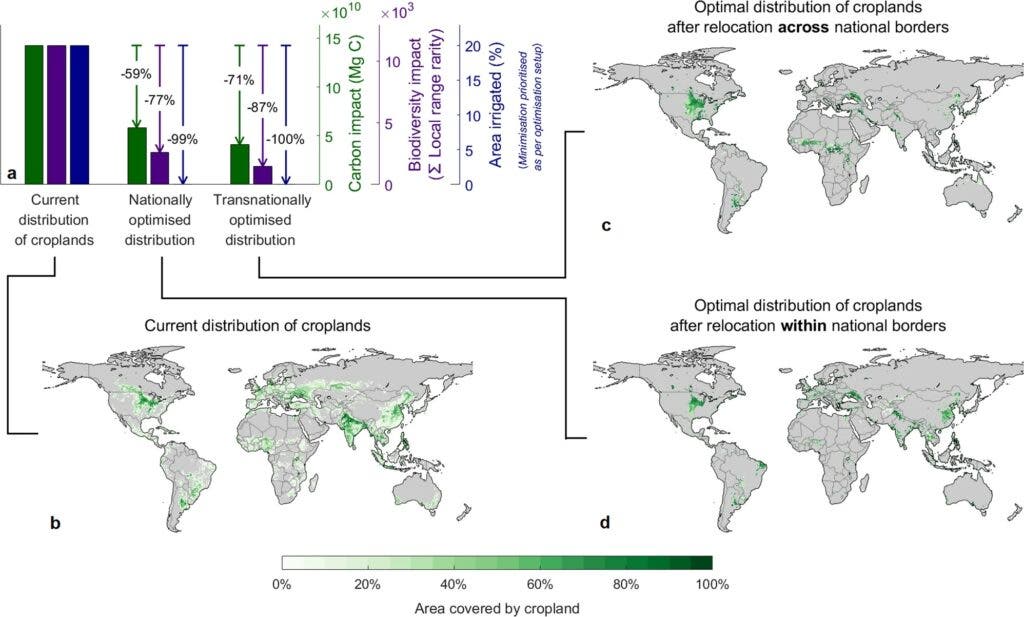
Across the world, once-thick forest areas and other natural habitats have made way for huge crop fields where we grow food for ourselves and our livestock. The damage to ecosystems and wildlife has been immense, leading to the collapse of entire ecosystems and the extinction of species, in some instances. Yet, at the same time, the world desperately needs high-yield, intensive agriculture in order to feed the many billions of people.
But while it may look like an inescapable dilemma in which we have to trade nature’s well-being for our own survival, it doesn’t necessarily have to be that way. There’s smart agriculture, and then there’s the chaotic, unplanned farming we see today. Recognizing this gap, researchers from Cambridge University have plotted a map showing where the world’s most important food crops should be grown to maximize yield while, at the same time, minimizing the environmental impact of agriculture.
According to the results, if the world’s croplands were to be moved to these optimal locations, the carbon impact linked to this industry would be slashed by 71% with no loss of yield compared to today’s crops. The redesign would allow huge empty fields to revert back to their natural, forested state, leading to substantial carbon capture in both the trees and soil. This reversal would take a few decades.
Wildlife would also benefit greatly. In such an optimized scenario, the stress on the world’s biodiversity would be reduced by 87%. According to a 2016 study, agriculture and the overexploitation of plants and animal species are significantly greater threats to biodiversity than climate change. Nearly three-quarters of the world’s threatened species faced these perils, compared to just 19% affected by climate change.
Last but not least, this redesign would virtually eliminate irrigation, since the designated croplands are located in regions where rainfall provides enough water for optimal plant growth. Around 70% of the world’s freshwater is used for agriculture, causing shortages in the driest parts of the world.
“In many places, cropland has replaced natural habitat that contained a lot of carbon and biodiversity – and crops don’t even grow very well there. If we let these places regenerate, and moved production to better-suited areas, we would see environmental benefits very quickly,” said Dr. Robert Beyer, formerly a researcher in the University of Cambridge’s Department of Zoology, and first author of the study.
The optimal agriculture map

For their study, the researchers analyzed the geography, yields, and growing conditions of 25 major crops, including wheat, barley, and soybean. Together, the areas under scrutiny comprise three-quarters of the global croplands.
Using a mathematical model, the researchers looked at multiple possible distribution scenarios that maintained overall food production for each crop. The results produced a shortlist of distribution patterns with the lowest environmental impact.
The relocation of croplands could be performed with the help of government schemes that financially compensate farmers to retire part or all of their land. This has been done before with some success to protect threatened biodiversity hotspots.
Even so, not even the researchers themselves believe that agriculture could ever be restricted only to the most optimal areas. There are insurmountable economical, social, and political barriers that would prevent this from happening.
For instance, the new study found new areas for optimal farming in the mid-western US and below the Saharan desert, while huge croplands in Europe and India are designated as suboptimal and should be replaced with natural habitats. But even countries with the worst soil for growing crops would prefer to finance their agricultural output as a matter of national security. There are also immense logistical hurdles and unaccounted-for consequences that come with concentrating food production on only some key areas of the world.
Redistributing the entire world’s croplands is not the point though. The map shows the location of the prime real estate for agriculture, which could help the industry distribute its efforts and resources in a more optimal fashion. We’ll never attain the environmental benefits of a 100% optimal farming strategy, but what we can do with this information could still prove immensely positive. At the very least, the most unproductive crops could be scrapped in favor of maximizing the environmental benefits.
For instance, redistributing croplands within national borders, as opposed to a global redistribution, would reduce global carbon impact by 59% and biodiversity impact by 77% compared to present levels.
Under an even more realistic plan, relocating the worst-performing 25% of croplands nationally would result in 50% of the benefits of optimally moving all croplands globally.
“It’s currently not realistic to implement this whole redesign. But even if we only relocated a fraction of the world’s cropland, focusing on the places that are least efficient for growing crops, the environmental benefits would be tremendous,” Beyer said in a press release.
The findings appeared in the journal Nature Communications Earth & Environment.


